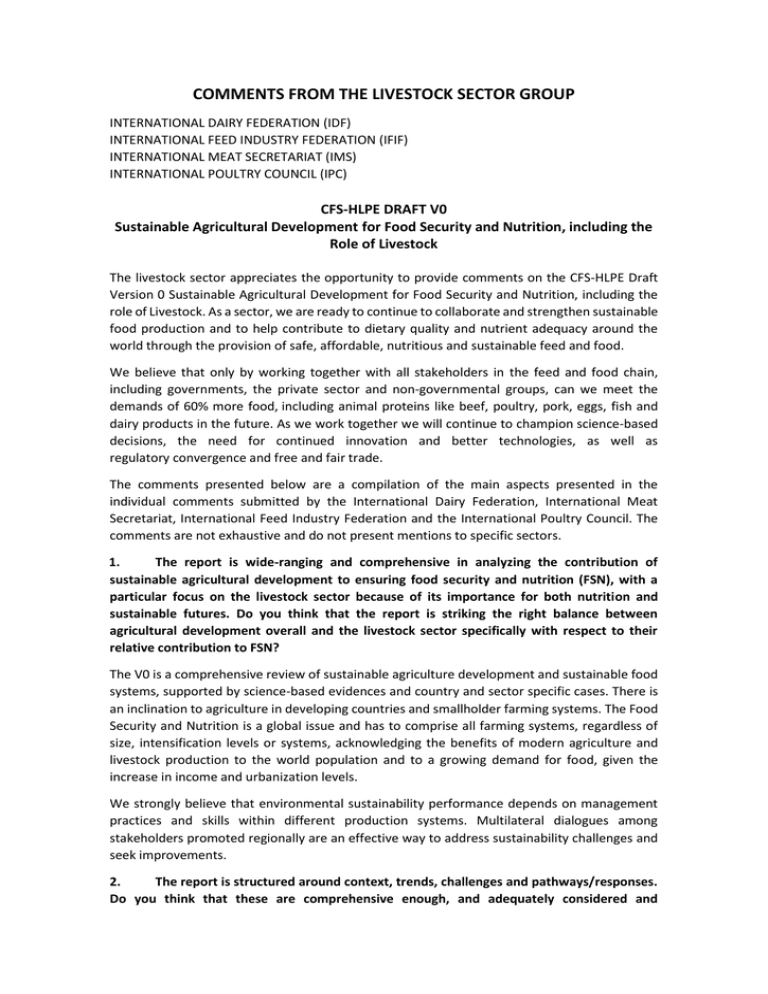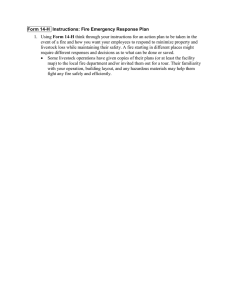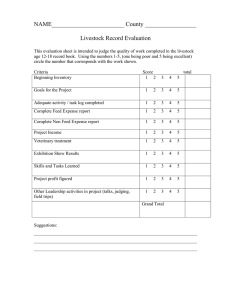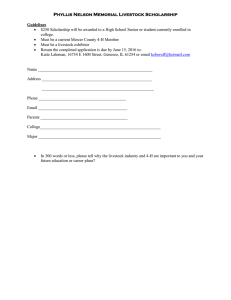COMMENTS FROM THE LIVESTOCK SECTOR GROUP
advertisement

COMMENTS FROM THE LIVESTOCK SECTOR GROUP INTERNATIONAL DAIRY FEDERATION (IDF) INTERNATIONAL FEED INDUSTRY FEDERATION (IFIF) INTERNATIONAL MEAT SECRETARIAT (IMS) INTERNATIONAL POULTRY COUNCIL (IPC) CFS-HLPE DRAFT V0 Sustainable Agricultural Development for Food Security and Nutrition, including the Role of Livestock The livestock sector appreciates the opportunity to provide comments on the CFS-HLPE Draft Version 0 Sustainable Agricultural Development for Food Security and Nutrition, including the role of Livestock. As a sector, we are ready to continue to collaborate and strengthen sustainable food production and to help contribute to dietary quality and nutrient adequacy around the world through the provision of safe, affordable, nutritious and sustainable feed and food. We believe that only by working together with all stakeholders in the feed and food chain, including governments, the private sector and non-governmental groups, can we meet the demands of 60% more food, including animal proteins like beef, poultry, pork, eggs, fish and dairy products in the future. As we work together we will continue to champion science-based decisions, the need for continued innovation and better technologies, as well as regulatory convergence and free and fair trade. The comments presented below are a compilation of the main aspects presented in the individual comments submitted by the International Dairy Federation, International Meat Secretariat, International Feed Industry Federation and the International Poultry Council. The comments are not exhaustive and do not present mentions to specific sectors. 1. The report is wide-ranging and comprehensive in analyzing the contribution of sustainable agricultural development to ensuring food security and nutrition (FSN), with a particular focus on the livestock sector because of its importance for both nutrition and sustainable futures. Do you think that the report is striking the right balance between agricultural development overall and the livestock sector specifically with respect to their relative contribution to FSN? The V0 is a comprehensive review of sustainable agriculture development and sustainable food systems, supported by science-based evidences and country and sector specific cases. There is an inclination to agriculture in developing countries and smallholder farming systems. The Food Security and Nutrition is a global issue and has to comprise all farming systems, regardless of size, intensification levels or systems, acknowledging the benefits of modern agriculture and livestock production to the world population and to a growing demand for food, given the increase in income and urbanization levels. We strongly believe that environmental sustainability performance depends on management practices and skills within different production systems. Multilateral dialogues among stakeholders promoted regionally are an effective way to address sustainability challenges and seek improvements. 2. The report is structured around context, trends, challenges and pathways/responses. Do you think that these are comprehensive enough, and adequately considered and articulated? Does the report strike the right balance of coverage across the various chapters? Are there important aspects that are missing? As far as the structure of the report is concerned, the livestock sector would like to stress the importance of putting environmental challenges of food production in relation to the contribution of essential nutrients. Debate should not be simplified by focusing only on a single environmental aspect or by comparing single nutrients or food items. In this sense, it would be important to have a structured classification of existing diets, in order to identify challenges and opportunities for different ASFs in a dietary context, in a more accurate way than it is done in Table 1, page 59. A chapter on the crucial role of infrastructures is missing. It is crucial that countries and regions make roads, waterways, railroads and other tailor made efficient, quality transport means available for everybody. Producers must be able to transport their produce to cities or further away, and able to get new equipment and other means to their often remote production areas via high quality, convenient roads. It is the task of governments to provide these - this is the best way to ensure that small producers and poor regions will get an opportunity to work themselves out of poverty. Equally important are schools for all, agricultural education at all levels, working supporting institutions, banking and loaning opportunities for all at rates and conditions comparable with those in developed countries. In addition to that, a glossary for terms and abbreviations used and an executive summary with key points would be helpful. 3. The report uses a classification to distinguish between four broad categories of livestock systems, in order to better identify specific challenges and sustainable development pathways for each of them. Do you find this approach useful for identifying specific policy responses and actions in different socio-economic and environmental contexts? The production systems represented by several livestock sector players does not fit in any of the proposed categories of livestock systems. There is a need for diversified categories that can actually address challenges and opportunities, as well as a revision on the description of those categories. 4. The report has identified a wide range of challenges likely to be faced in the coming period to which policy makers and other stakeholders will need to take into account so that SADL can contribute to FSN. Do you think that there are other key challenges/opportunities that need to be covered in the report, including those related to emerging technologies, the concentration and intensification of production in livestock, and the implications for feedstuffs (crops and oilseeds), and international trade? The report could explore the new climate change mitigation technologies that are being developed and the challenges for successful their development and adoption. It should also bring more focus to the social and economic aspect of livestock production and its capacity of generating income, creating jobs and keeping people to their land. Productivity will have to increase and efficiency gap will need to be reduced, but it will only be possible with new technologies and intensification of production. 5. A decision-making approach that could be useful for policy makers in designing and implementing policies and actions has been proposed in Chapter 4 of the report. Is this a useful and pragmatic approach? Yes, it seems to be useful and pragmatic. 6. Chapter 4 also contains case studies/examples of evolutions of agricultural development policies and actions in different contexts/countries. Could you offer other practical, well-documented and significant examples to enrich and provide better balance to the variety of cases and the lessons learned in agricultural development, including the trade offs or win-win outcomes in terms of addressing the different dimensions of sustainability and FSN? Specific case-studies are provided in the comments submitted individually by each livestock sector organization. 7. The social dimension of sustainable agriculture development has often been less well described and understood, including due to lack of data. Examples and experiences on such issues (livelihoods, gender, share and situation of self employed versus wage workers, working conditions, etc.) would be of particular interest to the team. Livestock sectors are responsible for the creation of millions of jobs around the world and for generating income from the land and avoiding a migration from rural to urban areas. There has been a large focus on the role of agriculture at the production base but less of an emphasis of the economic value of the creation of value chains and its economic impact and the cost/benefit of producing and providing food to consumers in country. The ability of the country to develop value chain markets and feed people has a rippling effect through the economy. Livestock is uniquely able to build value chains through the cooperative and integration systems. 8. The upstream and downstream sectors are playing an increasingly important role in respect of the orientation of agricultural development, food choices and diets. Can you provide examples of the role these sectors play in sustainable agricultural development and FSN? 9. What are the key policy initiatives or successful interventions to improve the sustainability of food systems, in different countries and contexts that merit discussion in the report? Is there evidence about the potential of economic incentives, and which ones (taxes, subsidies etc.), regulatory approaches, capacity building, R&D and voluntary actions by food system actors? An analysis of public investment in the livestock sector should be included in this report. This is important since public investment in the livestock sector has not been increasing, despite increases in livestock’s contribution to agricultural GDP. The authors rightly point out that subsidies have typically been provided for productivity, making farming systems less vulnerable to climate change, and harnessing agriculture to deliver more environmental services. While these are positive uses of subsidies, the agriculture sector as a whole has had a decrease in the level of funding for research and innovation and applied research and extension. We need an increased focus on technology transfer and an increase in funding to support worldwide soil research, and in particular to agriculture, the investment in manure as a resource for soil amendment and fertilizer. 10. The design and implementation of policies for FSN requires robust, comparative data over time and across countries. Where are the data gaps that governments, national and international organizations might need to address in the future in order to understand trends and formulate better policies? 11. Are there any major omissions or gaps in the report? Are topics under-or overrepresented in relation to their importance? Are any facts or conclusions refuted or questionable? If any of these are an issue, please send supporting evidence. The importance of the prudent use of antibiotics should be mentioned in the report. Prudent uses of antibiotics are necessary in animal husbandry in order to take care of animal welfare, avoid chronic infected animals, and have a sustainable animal husbandry. Sick animals with pain and suffering should be treated in a correct way to have a good animal welfare and avoiding developing chronic infections. At the same time healthy animals should not be treated as part of a routine or management system, as well as treating chronic infected animals that cannot recover to healthy state should be avoided. Additionally, a more comprehensive approach to the role of animal welfare in the livestock sector should be included. The authors point out the increase in agriculture’s use of nitrogen, but fail to mention the potential role of livestock in cycling nitrogen through animals and providing nitrogen that then can be used to offset the importation of new nitrogen to a watershed. The panel would do well to look at the nitrogen cycling potential of animals and the role of manure to offset imported nitrogen to watersheds.


